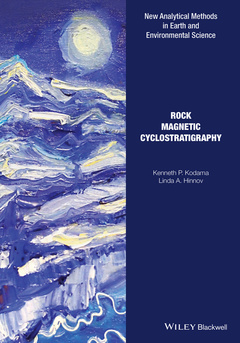Rock Magnetic Cyclostratigraphy Analytical Methods in Earth and Environmental Science Series
Auteurs : Kodama Kenneth P., Hinnov Linda A.

Rock magnetic cyclostratigraphy merges environmental magnetism, in which rock magnetic measurements are used to detect past environmental change, and cyclostratigraphy, in which cyclic variations of lithology or a sedimentary rock?s physical properties are related to astronomically-forced paleoclimate change. In addition to providing paleoclimate data, cyclostratigraphy can establish high-resolution chronostratigraphy for a sequence of sedimentary rocks, even at distant times in Earth?s history. This book provides an overview of concepts underlying these two techniques, recipes for the time series analysis of cyclostratigraphy, and case studies to illustrate the variety and breadth of problems addressed by rock magnetic cyclostratigraphy.
New Analytical Methods in Earth and Environmental Science
Because of the plethora of analytical techniques now available, and the acceleration of technological advance, many earth scientists find it difficult to know where to turn for reliable information on the latest tools at their disposal, and may lack the expertise to assess the relative strengths or limitations of a particular technique. This new series will address these difficulties by providing accessible introductions to important new techniques, lab and field protocols, suggestions for data handling and interpretation, and useful case studies. The series represents an invaluable and trusted source of information for researchers, advanced students and applied earth scientists wishing to familiarise themselves with emerging techniques in their field.
All titles in this series are available in a variety of full-colour, searchable e-book formats.
1 Introduction 1
1.1 Rock Magnetic Cyclostratigraphy 1
1.2 Basic Steps of a Rock Magnetic Cyclostratigraphy Study 4
1.3 The Significance of Rock Magnetic Cyclostratigraphy 6
1.4 Layout of the Book 7
References 8
2 Rock Magnetism 10
2.1 Introduction 10
2.2 Types of Magnetism 12
2.3 Ferromagnetic Minerals 16
2.4 Fine Particle Magnetism 20
2.4.1 Hysteresis 20
2.4.2 Magnetic Particle Anisotropy 24
2.4.3 Domain State 25
2.5 Environmental Magnetic Parameters 26
2.5.1 Individual Environmental Magnetic Parameters 26
2.5.2 Ratios of Environmental Magnetic Parameters 29
2.6 Identification of Magnetic Mineralogies and Choosing a Rock Magnetic Parameter for Cyclostratigraphy 31
References 32
3 Magnetostratigraphy 35
3.1 Introduction 35
3.2 Measuring Magnetostratigraphy 37
3.2.1 Sampling Strategy 37
3.2.2 Sample Collection 37
3.2.3 Measurement and Demagnetization 38
3.2.4 Tests to Constrain the Age of Remanence 41
3.2.5 Plotting of Magnetostratigraphic Data and Determining a Reversal Stratigraphy 42
3.3 Tying to the GPTS 46
3.4 Providing the Best Time Resolution from Magnetostratigraphy 49
References 49
4 Time Series Analysis for Cyclostratigraphy 52
4.1 Introduction 52
4.2 Geological Time Series 53
4.3 Time Series Analysis Tools and Eocene Arguis Rock Magnetic Cyclostratigraphy 54
4.3.1 Sampling and Interpolation 54
4.3.2 Detrending, Smoothing, and “Prewhitening” 56
4.3.3 Filtering Basics 56
4.3.4 Digital Filters 58
4.3.5 Spectral Analysis 58
4.3.6 Hypothesis Testing and Noise Modeling 73
4.3.7 Time-Frequency Analysis 81
4.3.8 Coherency and Cross-Phase Analysis 83
References 87
5 Milankovitch Forcing Theory 90
5.1 Introduction 90
5.2 Astronomical Parameters 90
5.3 Insolation 93
5.4 Astronomical Tuning and Timescales 93
5.4.1 The Initial Timescale 93
5.4.2 Traditional Astronomical Tuning 96
5.4.3 Objective Astronomical Tuning 97
References 97
6 Case Studies of Rock Magnetic Cyclostratigraphy 99
6.1 Introduction and Environmental Shredding 99
6.2 Stirone River Section, Northern Italy 101
6.3 Arguis Formation, Spanish Pyrenees 104
6.4 Cupido Formation Platform Carbonates, Northeastern Mexico 107
6.5 Latemar Massif, Triassic Carbonates, Northern Italy 111
6.6 Daye Formation, Triassic Carbonates, South China 113
6.7 Mauch Chunk Formation: Mississippian Red Beds, Pottsville, Pennsylvania 117
6.8 Rainstorm Member of the Neoproterozoic Johnnie Formation, Death Valley, California 119
6.9 Encoding of Orbitally Forced Climate Signals 123
References 124
7 Doing Rock Magnetic Cyclostratigraphy 128
7.1 Study Design 128
7.2 Field Sampling 131
7.3 Laboratory Preparation 132
7.4 Remanence Measurements 134
7.5 Time Series Analysis: Summary of Procedures 137
7.5.1 Preparation of the Data Series 138
7.5.2 Spectral Estimation 138
7.5.3 Significance of the Spectral Peaks 139
7.5.4 Evolutionary Spectrogram 140
7.5.5 Tuning and Filtering 140
7.6 Identifying Astronomically Forced Climate Cycles 141
References 143
Appendix 145
Glossary 157
Index 161
Kenneth P. Kodama is Professor of Earth and Environmental Sciences at Lehigh University, USA. He has taught Earth sciences and conducted paleomagnetic and rock magnetic research with his students at Lehigh for the past 36 years. In his time away from paleomagnetism he enjoys playing music.
Linda A. Hinnov is a research Professor at Johns Hopkins University, USA specializing in the astronomical forcing of Earth’s paleoclimate system. She has longstanding interests in cyclostratigraphy, and its implications for the evolution of Earth’s geophysical and astronomical parameters and the geologic time scale.
Date de parution : 10-2014
Ouvrage de 176 p.
18.8x26.4 cm
